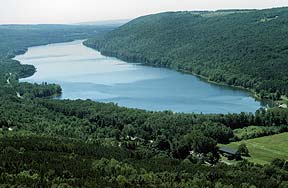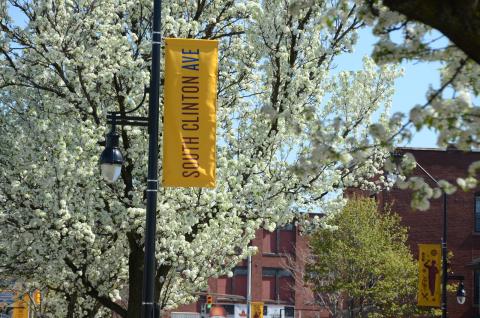Hemlock Lake
Hemlock Lake Park
7412 Rix Hill Rd
Hemlock, NE 14466
United States


The photo above is of the north end of Hemlock Lake, taken from the hillside directly east of this scene. It was taken sometime in the early 1900's. The small building at the foot of the lake (right side), known as the Gatehouse, was the original "treatment plant" for Rochester's water system. The current treatment facility (constructed in 1993) is located directly east (this side of) the Gatehouse. The Gatehouse was demolished in 2000, after it was determined that it was not practical to restore it for historical purposes.
"Glory! Hemlock Water at Last!"
So proclaimed the newspaper headline on January 24, 1876 as it announced the arrival of Hemlock Lake water into Mt. Hope Reservoir (today named Highland Reservoir). Finally, after more than three decades of political bickering and aborted construction attempts, Rochester had an abundant supply of pure wholesome drinking water. While an asset such as this may barely raise an eyebrow today, in 1876 this was truly a glorious event for the 70,000 citizens of Rochester.
In the era before the arrival of Hemlock water, wells and cisterns were the only source of drinking water. For the average resident, one well or cistern was shared by several families. Not surprisingly, the water quality of these wells was terrible in a city honeycombed with cesspools and privies. The author of an 1875 Board of Health report stated that, "We have few wells in our city that are fit for use, and in the densely populated portion they are almost without exception, absolutely unfit." Diseases such as dysentery, cholera and typhoid were widespread. Periods of drought amplified these hardships
Water for fire-fighting during this era was drawn from the Erie Canal and piped to underground storage chambers throughout the city. As a consequence, this supply of water became very low during times of drought, or in the winter when the canal froze up, thereby creating the potential for minor fires to turn into major conflagrations
Compelled by the great need of the community and the more than three decades of failed attempts by the private sector to build a water system, a small group of Rochester residents petitioned the state legislature for the passage of an act allowing the city to construct a system of water works at its own expense. The result was the passage of the law entitled, "an act to supply the city of Rochester with pure wholesome water" on April 27, 1872. By this act the mayor was directed to appoint five persons to constitute a "board of water commissioners," who were to "examine and consider all matters relative to supplying the City of Rochester with a sufficient quantity of pure and wholesome water for the use of its inhabitants, and for the extinguishment of fires." On April 29, 1872, Mayor A. Carter Wilder appointed five citizens to the board.
The mayor's action raised the immediate ire of the city's Common Council and some of the city's wealthier residents, who, fearing a large tax increase to fund the water system, still favored private sector control. Lawsuits questioning the constitutionality of the law were filed by council, however, in every case the courts ruled in favor of the commissioners. The first act of the five member board was to appoint J. Nelson Tubbs as chief engineer. Born in Schoharie County, Tubbs completed his rudimentary education and by the age of eighteen, had graduated from the State Normal College at Albany. He then took up the study of mathematics under George Perkins, the author of several textbooks. Subsequently, he began to study law under the tutelage of several prominent judges. When ill-health forced him to give up his law career shortly before being admitted to the bar, he took a job with the state as an engineer on the Erie Canal, a position which he held for the next eighteen years. Tubbs possessed the confidence and the abilities that were critical to the success of the water works project. While thoroughly versed in the science of his profession, he was not afraid to improvise his own methods when he thought that there was a better way of doing things. His flair for showmanship, his calmness under pressure, and his ability to skirt any embarrassing political barbs made him the ideal man for the job
Tubbs, with the blessing of the commissioners, chose Emil Kuichling as his assistant. Kuichling, who was born in Germany in 1848 and was brought to Rochester the following year, obtained his B.A. degree in 1868 and his engineering degree in 1869, both from the University of Rochester. He returned to Germany and received his civil engineering degree from the Polytechnic School at Carlsruhe in 1872.
Possessing many of the same talents and attributes as Tubbs, his great skills and attention to detail can be seen even today in his beautiful hand-colored construction drawings (several of which are on display in this gatehouse) which cover every aspect of the project.
Ground was broken on June 1, 1873, and in the remarkably short timespan of less than two years and eight months, the waters of Hemlock Lake were rushing through the conduit and flowing into Mt. Hope Reservoir. All told, the project's accomplishments included, 28-1/2 miles of cast-iron and wrought -iron conduit, two reservoirs with a combined capacity of 120 million gallons of water, 58 miles of distribution mains, 521 hydrants, 745 valves and a Holly high-pressure system with a pumping capacity of 7 million gallons per day for fire-fighting purposes.
Today, gravity still carries the water through the conduits, just as the original planners had envisioned. That their pioneering water system has stood the test of time stands as a fitting tribute to the foresight and genius of those who designed, planned and built the Rochester Water Works.






